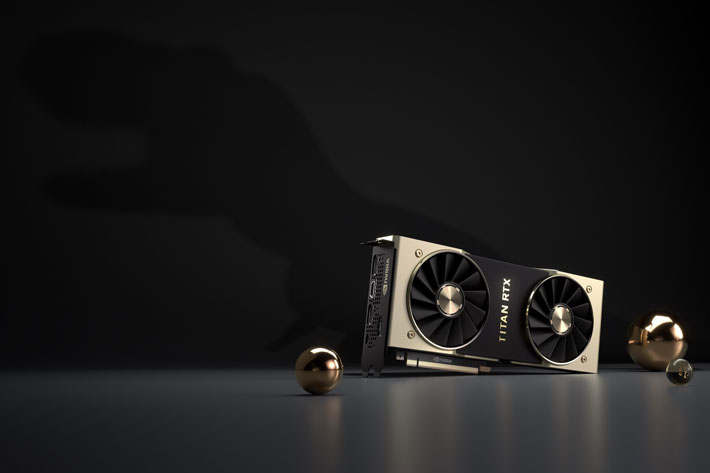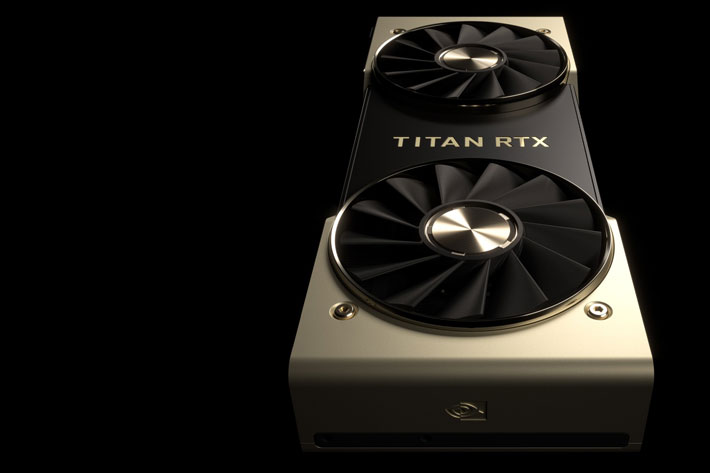
Dubbed T-Rex, Nvidia’s new Titan RTX is announced as the world’s most powerful desktop GPU, providing massive performance for AI research, data science and creative applications.
Gamewise, ray-tracing has yet to proven itself as a game changer, but that does not mean that the technology with which Nvidia moves its graphics cards to a new level is not interesting for a series of other applications. The new card now announced, TITAN RTX, is the example of Nvidia moving forward, with what the company says is its greatest leap since the invention of the CUDA GPU in 2006.
So, 12 years in the making, the Turing-powered Titan delivers 130 Teraflops of deep learning horsepower, 11 gigarays of ray-tracing performance to world’s most demanding users, revealed Nvidia today, at the Conference on Neural Information Processing Systems, in Montreal, Canada.
“Turing is NVIDIA’s biggest advance in a decade – fusing shaders, ray tracing, and deep learning to reinvent the GPU,” said Jensen Huang, founder and CEO of NVIDIA. “The introduction of T-Rex puts Turing within reach of millions of the most demanding PC users — developers, scientists and content creators.”

Titan RTX for the next-gen virtual reality
The new Nvidia Turing architecture, which is the result of more than 10,000 engineering-years of effort, features new RT Cores to accelerate ray tracing, plus new multi-precision Tensor Cores for AI training and inferencing. These two engines — along with more powerful compute and enhanced rasterization — enable capabilities that will transform the work of millions of developers, designers and artists across multiple industries.
Designed for a variety of computationally demanding applications, Titan RTX provides an unbeatable combination of AI, real-time ray-traced graphics, next-gen virtual reality and high performance computing. It delivers:
- 576 multi-precision Turing Tensor Cores, providing up to 130 teraflops of deep learning performance.
- 72 Turing RT Cores, delivering up to 11 GigaRays per second of real-time ray-tracing performance.
- 24GB of high-speed GDDR6 memory with 672GB/s of bandwidth — 2x the memory of previous-generation TITAN GPUs — to fit larger models and datasets.
- 100GB/s NVIDIA NVLink can pair two Titan RTX GPUs to scale memory and compute.
- Incredible performance and memory bandwidth for real-time 8K video editing.
- VirtualLink port provides the performance and connectivity required by next-gen VR headsets.
Titan RTX costs $2,499
With AI being another buzzword these days, the Titan RTX appears as the solution for all AI researchers and Deep Learning developers, as it transforms, says Nvidia, “the PC into a supercomputer”. The card provides multi-precision Turing Tensor Cores for breakthrough performance from FP32, FP16, INT8 and INT4, allowing faster training and inference of neural networks. It offers twice the memory capacity of previous generation Titan GPUs, along with NVLink to allow researchers to experiment with larger neural networks and data sets.
The new card is also the perfect solution for data scientists, says the company, as it accelerates data analytics with RAPIDS. RAPIDS open-source libraries integrate seamlessly with the world’s most popular data science workflows to speed up machine learning.
Last but not least, content creators have also been in Nvdia’s plans while developing the Titan RTX. The card brings the power of real-time ray tracing and AI to creative applications, so 5 million PC-based creators can iterate faster. It also delivers the computational horsepower and memory bandwidth needed for real-time 8K video editing. That’s, I believe, something readers here at ProVideo Coalition welcome. Now the price: Titan RTX will be available later this month in the U.S. and Europe for $2,499.

